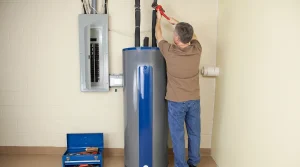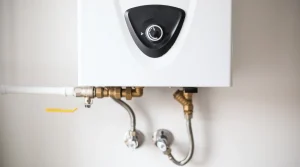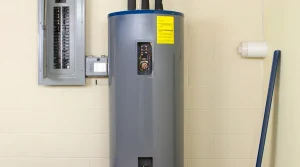Are strange noises coming from your furnace? Worried about sky-high heating bills this winter? Your furnace works tirelessly to keep your home warm during the coldest months, but without proper maintenance, it could leave you in the cold when you need heat the most.
Most homeowners don’t think about their furnace until something goes wrong. Unfortunately, by then, you’re facing expensive emergency repairs or even complete system replacement. The good news? Simple, regular furnace maintenance can prevent most common heating issues while extending your system’s lifespan and reducing your energy costs.
In this comprehensive guide, we’ll walk you through everything you need to know about furnace maintenance, from DIY tasks you can handle yourself to when it’s time to call in the professionals.
Why Furnace Maintenance Matters
Before diving into specific maintenance tasks, let’s understand why regular furnace care is so important:
- Extended system lifespan – Regular maintenance can add 5-10 years to your furnace’s operational life
- Lower energy bills – A well-maintained furnace runs more efficiently, using less energy to produce the same heat
- Improved air quality – Clean components mean cleaner air circulating through your home
- Enhanced safety – Regular checks can identify potential carbon monoxide risks before they become dangerous
- Warranty protection – Most manufacturer warranties require annual professional maintenance
Now, let’s explore the essential furnace maintenance tasks that will keep your system running smoothly all winter long.
10 Essential Furnace Maintenance Tasks
1. Replace or Clean Air Filters Regularly
Why it matters: Clean filters are the frontline defense for your furnace. They prevent dust and debris from damaging internal components while ensuring proper airflow for efficient operation.
Dirty filters force your furnace to work harder, increasing energy consumption and potentially causing overheating. For most homes, filters should be checked monthly during heating season and replaced every 1-3 months depending on:
- Filter type (disposable vs. reusable)
- Air quality in your home
- Presence of pets
- Family members with allergies or respiratory conditions
Pro tip: Write the date on your filter when you install it so you’ll know exactly when it was last changed.
2. Clean Vents and Ductwork
Your heating system can only perform at its best when air flows freely. Over time, dust and debris accumulate in vents and ductwork, restricting airflow and potentially harboring allergens.
DIY vent cleaning steps:
- Turn off your heating system completely
- Cover supply registers with paper towels or microfiber cloths
- Remove and clean all vent covers with warm, soapy water
- Use a vacuum with a long hose attachment to clean accessible ducts
- For a deeper clean, consider professional duct cleaning services
For extensive ductwork cleaning, professional equipment will reach areas that household vacuums simply can’t.
3. Inspect and Clean the Heat Exchanger
The heat exchanger is the heart of your furnace, responsible for heating the air that circulates throughout your home. A clean heat exchanger operates more efficiently and, most importantly, prevents dangerous carbon monoxide leaks.
Safety warning: Always turn off power to your furnace and shut off the gas supply before attempting any heat exchanger maintenance.
For thorough cleaning:
- Use a soft brush to remove loose debris
- Wipe down accessible areas with a damp microfiber cloth
- Vacuum remaining dust with a narrow attachment
Older furnaces particularly benefit from professional heat exchanger inspection, as cracks can develop over time that may not be visible to untrained eyes.
4. Maintain the Blower Motor and Fan
Your furnace’s blower motor circulates warm air throughout your home. Dust accumulation can cause it to work harder, leading to premature wear and inefficient operation.
To clean the blower assembly:
- Turn off all power to the furnace
- Close the gas supply valve
- Remove the blower door (consult your owner’s manual)
- Carefully clean the blower wheel using a small brush
- Vacuum the cabinet and blower area
- Check if your model requires periodic lubrication (refer to manufacturer instructions)
A properly maintained blower not only improves efficiency but also reduces the noise your system makes during operation.
5. Check Thermostat Functionality
Even the best-maintained furnace can’t perform properly if your thermostat isn’t working correctly. Before winter arrives:
- Test your thermostat by setting it to “heat” and raising the temperature setting
- Listen for your furnace to activate within a minute
- Check if the actual temperature matches the thermostat reading
- Replace batteries if your thermostat is battery-powered
- Ensure all wiring connections are secure
Consider upgrading to a programmable or smart thermostat to improve comfort and reduce energy costs. Modern thermostats can save up to 10% annually on heating expenses through efficient temperature management.
6. Update Safety Devices
Your home’s safety devices work hand-in-hand with your furnace to protect your family. At minimum, annually:
- Replace batteries in smoke detectors
- Replace batteries in carbon monoxide detectors
- Test all safety devices to ensure proper function
- Consider adding carbon monoxide detectors if you don’t already have them
Carbon monoxide is odorless and colorless, making detectors essential for any home with fuel-burning appliances like furnaces.
7. Eliminate Unusual Odors
When you first turn on your furnace after the off-season, a slight burning smell is normal as dust burns off the heat exchanger. However, this should dissipate quickly.
Persistent or unusual odors might indicate:
- Electrical burning smell: Potential wiring issues requiring immediate attention
- Rotten egg smell: Possible gas leak – evacuate immediately and call your gas company
- Musty odors: Potential mold in your system
- Chemical smell: Possible heat exchanger crack (very serious safety issue)
Always investigate unusual furnace smells promptly, as they often signal problems that require professional attention.
8. Keep the Area Around Your Furnace Clear
The space around your furnace should remain clean and uncluttered for both efficiency and safety reasons:
- Maintain at least 30 inches of clearance around your furnace
- Never store flammable materials (paint, cleaning supplies, gasoline) near your heating system
- Keep the area dust-free to prevent debris from entering the system
- Ensure proper ventilation in the furnace room
This simple step prevents fire hazards while ensuring your system has proper airflow for efficient operation.
9. Schedule Professional Pre-Season Inspection
Even with diligent DIY maintenance, annual professional inspection remains crucial for:
- Comprehensive safety checks
- Internal component inspection
- Combustion efficiency testing
- System calibration for optimal performance
- Early identification of potential issues
- Warranty protection
Most HVAC professionals recommend scheduling this service in early fall, before the heating season begins and service companies become extremely busy.
What to expect during professional maintenance:
- Complete system inspection
- Burner cleaning and adjustment
- Electrical connection tightening
- Moving part lubrication
- Condensate drain cleaning
- Thermostat calibration
- Safety control testing
10. Know When to Upgrade Your System
No amount of maintenance can indefinitely extend the life of an aging, inefficient furnace. Most systems have an expected lifespan of 15-20 years, after which replacement often makes more financial sense than continued repairs.
Signs it might be time for replacement include:
- Age exceeding 15 years
- Frequent repairs in recent years
- Steadily increasing energy bills
- Uneven heating throughout your home
- Excessive noise during operation
- Visible rust or cracks
Modern furnaces offer significantly improved efficiency ratings that can reduce your heating costs by 15-30% compared to older models.
Creating a Furnace Maintenance Schedule
To make furnace maintenance manageable, break tasks down by frequency:
Monthly tasks (during heating season):
- Check and replace air filters as needed
- Listen for unusual noises
- Monitor thermostat performance
Seasonal tasks (before heating season):
- Clean vents and accessible ductwork
- Test safety devices and replace batteries
- Check thermostat functionality
- Schedule professional maintenance
Annual professional service:
- Complete system inspection and cleaning
- Efficiency testing
- Safety check
When to Call a Professional
While many maintenance tasks are DIY-friendly, certain situations always warrant professional attention:
- Gas smell or suspected leak
- Persistent unusual odors
- Yellow or flickering pilot light
- Frequent system cycling
- Unusual noises (banging, rattling, squealing)
- Failure to heat properly
- Significant increase in energy bills
Remember that working with gas lines, electrical components, or complex furnace parts can be dangerous without proper training and tools.
Conclusion: A Small Investment for Major Returns
Regular furnace maintenance isn’t just about preventing the inconvenience of a mid-winter breakdown—it’s about protecting your family’s comfort, safety, and finances. The small investment of time and money in preventative care delivers remarkable returns through improved efficiency, extended equipment life, and peace of mind.
Don’t wait until you’re shivering in a cold house to think about your furnace. Take action today to ensure your heating system is ready to perform when you need it most.
Need Professional Furnace Maintenance?
Trust the experienced team at BJC Clifton Plumbers to keep your heating system running safely and efficiently all winter long. Our comprehensive maintenance services identify potential issues before they become costly problems.
Contact us today at (973) 858-5005 to schedule your pre-season furnace maintenance appointment, or visit our website to learn more about our complete HVAC servic




